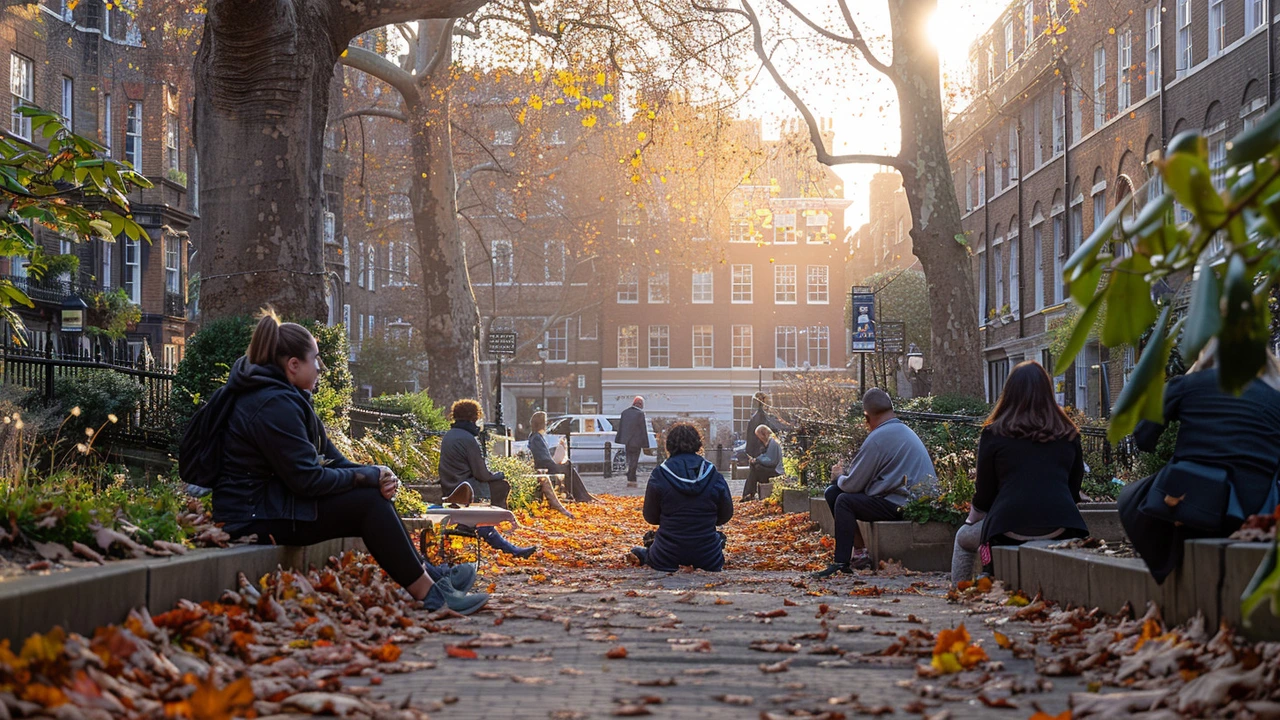
The quest for tranquility often seems like a daunting task, especially in the chaos of everyday life. However, a few minutes of targeted relaxation techniques can significantly impact your stress levels and overall mental health. From the simplicity of breathing exercises to the engaging nature of mindful listening, these techniques don't require special conditions or tools. They are accessible tools designed to be your companions, quietly whisking you away to a state of calm amidst any storm.
- Breathing Exercises
- Mindful Observation
- Progressive Muscle Relaxation
- Quick Visualizations
- Mindful Listening
Breathing Exercises
One of the most powerful yet understated tools we have for managing stress is our breath. Breathing exercises, often a core component of yoga and meditation, involve controlling your breath to induce relaxation. These exercises work because they help shift your body's response from the fight-or-flight mode to a more relaxed state. This shift is facilitated by the autonomic nervous system, specifically stimulating the parasympathetic nervous system, which helps slow down the heart rate and lower blood pressure.
One popular technique is the 4-7-8 breathing method. This involves breathing in for four seconds, holding the breath for seven seconds, and exhaling for eight seconds. This method is praised for its simplicity and effectiveness, providing a mental anchor that prevents the mind from wandering into stressful thoughts. A study published by the American Institute of Stress found that regular practice of controlled breathing can reduce symptoms of anxiety, insomnia, post-traumatic stress disorder, and depression.
Another technique is diaphragmatic breathing, also known as belly breathing. This involves focusing on expanding the stomach rather than the chest when breathing in. This type of breathing maximizes the amount of oxygen that goes into your lungs and subsequently to your brain, promoting a full exchange of oxygen and carbon dioxide. It's particularly beneficial in managing the physiological symptoms of stress, improving both mental and physical health.
Incorporating these breathing exercises into your daily routine can be as simple as taking a few minutes in the morning to practice or using them to unwind before bed. The beauty of breathing exercises is that they require no special equipment and can be done anywhere, whether in a quiet room or a bustling office. By regularly practicing these techniques, you can significantly enhance your ability to manage stress and improve your overall well-being.
Mindful Observation
Mindful observation invites us to engage with our immediate environment in a way that promotes calm and mindfulness. It essentially involves focusing on things we often overlook or take for granted. This can be anything from the play of sunlight through your window to the intricate patterns of a leaf. By directing our attention to these details, we not only foster a greater appreciation for the world around us, but we also distract our mind from our stressors, allowing calm to seep in. This practice doesn’t need any special tools or settings; it can be done while you are sitting in your car, waiting at the dentist, or taking a brief walk during your lunch break.
To start with mindful observation, select a natural object from your immediate surroundings. It could be a cloud in the sky, a flower in your garden, or even a painting on the wall. Focus all your attention on this object. Observe it in such detail as if you are seeing it for the first time. Think about its colors, shapes, texture, and features. Notice how your focus on this object allows your other thoughts to dissipate, making room for a calm sense of presence.
As your skills grow, you can expand your observations to more dynamic environments, such as observing the interaction between people in a crowded room or watching the changing colors during sunset. The key is to remain fully present in the moment without judgment. You will find that your capacity for mindfulness strengthens, and your sense of inner peace increases. This technique is not only a refuge from the stresses of everyday life but also a way to cultivate a deeper connection with the world around you.
Progressive Muscle Relaxation
Imagine you're holding a rubber ball. Now, clench that rubber ball with all your might, and just as you feel the tension in your hand, release it. That's the essence of Progressive Muscle Relaxation (PMR)—a technique that has been aiding people in combating stress since Dr. Edmund Jacobson developed it in the early 20th century. PMR is based on the simple yet profound principle of alternately tensing and then releasing specific muscle groups in the body. This method not only helps in easing muscular tension but significantly contributes to overall stress reduction.
The process starts by finding a comfortable spot. You could be seated or lying down. The key is to ensure that your body is in a relaxed posture without any external disturbances. Begin with your feet and gradually move up to your head, focusing on one muscle group at a time. For instance, tighten the muscles in your feet for about five seconds, and then relax them for 30 seconds, consciously feeling the tension leave your body. This shift from tension to relaxation alerts your brain to the state of calmness, influencing both your physical and mental health.
One significant benefit of PMR is its ability to decrease symptoms associated with stress-related disorders such as anxiety and insomnia. Studies suggest that regular practice of PMR can also lower blood pressure and heart rate, essentially teaching your body a new way to respond to stress. It's a technique that champions the connection between mind and body, emphasizing that physical calm can lead to mental serenity.
Insights into the efficacy of PMR can be traced back to several research studies. For example, a controlled experiment demonstrated a statistically significant decrease in anxiety levels among participants who practiced PMR regularly. This not only underscores the effectiveness of the technique but also highlights its utility as a part of daily stress management routines.
To integrate PMR into your daily routine, follow this simple step-by-step guide:
- Choose a quiet place and sit or lie down comfortably.
- Start with your feet and progressively move upward to your facial muscles.
- Tense each muscle group strongly (without straining) for about five seconds.
- Relax the muscle group for 30 seconds, focusing on the release of tension.
- Proceed to the next muscle group.
Quick Visualizations
Imagine being able to transport yourself to a serene beach or a quiet forest glade in the blink of an eye. That's the power of quick visualizations, a relaxation technique that uses the mind's ability to conjure images to quickly calm the body and ease stress. This method is particularly useful during high-pressure situations or when you find it challenging to concentrate. Visualization is not just a whimsical escape but is rooted in solid science. Studies have shown that the act of visualizing peaceful scenes can activate the brain's relaxation responses, reducing anxiety and improving mood.
To practice quick visualization, find a comfortable position, close your eyes, and take a few slow, deep breaths. Begin to picture a place that represents calm and peace to you. It might be a sunny beach, a quiet forest, a mountain summit at dawn, or even a cozy room filled with books. Try to incorporate as many senses as you can in your visualization. Hear the waves crashing or the birds singing, feel the sun or the breeze on your skin, smell the ocean or the pine trees. The more immersive your scene, the more effective the relaxation will be. Keep this image in your mind for a few minutes, allowing your brain to transition into a state of tranquility.
For those skeptical about the efficacy of such a simple tool, it might be interesting to note that athletes and performers often use visualization techniques to enhance their focus and performance before a game or show. These mental rehearsals are reported to stimulate the same neural pathways used during the actual performance of the activity, which boosts their overall performance under pressure.
Mindful Listening
Mindful listening might sound like an easy task, but in reality, it calls for a significant refinement of one's attention and focus. It's not merely about hearing the sounds around you; it's an active engagement with the environment to deepen the understanding of our surrounding sonic landscape. This form of mindfulness can drastically improve relationships and enhance the listener's emotional well-being, as it encourages a genuine appreciation and a non-judgmental acceptance of the present moment. To practice mindful listening, start by finding a comfortable place where you can relax without interruptions.
Begin by closing your eyes and allowing yourself to become aware of the variety of sounds that surround you. This might include the distant hum of traffic, the rhythmic ticking of a clock, or even the subtle sounds of your own breathing. The key is to listen without trying to identify or judge these sounds. Let them come and go. This practice can lead to surprising discoveries about your environment and can significantly reduce feelings of anxiety and stress. As you shift from being a passive receiver of sounds to an active listener, you should notice a heightened sense of being in the moment.
When done effectively, mindful listening can foster a deeper connection with oneself and with others. It teaches us to be present with the person speaking to us, rather than planning our next response while they talk. This tuning in without preempting can tremendously uplift the quality of our interactions and communications. It can turn everyday exchanges into meaningful dialogues and can build deeper, more empathetic relationships. So, as you undertake this practice, notice how it changes your conversations and connections.
Here's a simple exercise to try: next time you are in a conversation, focus solely on what the other person is saying. Resist the urge to interrupt, plan your answer, or pass judgment. Notice the impact this has on the conversation. Chances are, it will not only improve the quality of your interaction but may also teach you something significant about the speaker and yourself. This, ultimately, is the essence of mindful listening—being fully present, open, and receptive, which enriches your understanding of the world and fosters genuine rapport.
